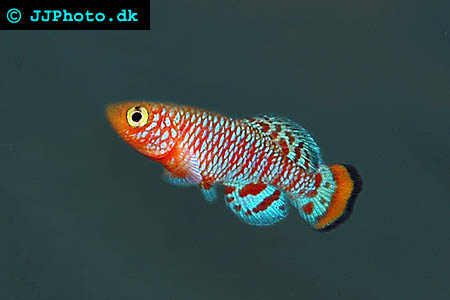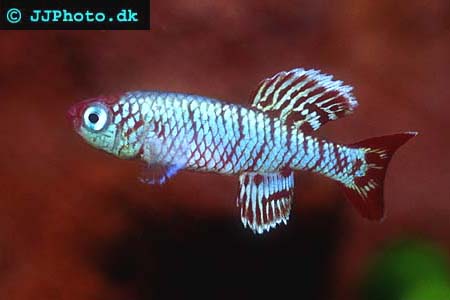Nothobranchius is one of several genera in the large Killiefish group. All Nothobranchius Killiefish originates from savannah regions in East Africa and heave developed to seasonal changes between heavy rains and severe draught. All Nothobranchius Killiefish are egg-layers that deposit their eggs in the mud. The eggs will then wait in the mud during the dry season and hatch when the rainy season begins. This also means that Nothobranchius Killiefish are very short lived, which of course is a serious drawback if you wish to keep them in your aquarium. When the Nothobranchius Killiefish has reached an age of 12 months it will usually look very aged and its colours will be fading. The Nothobranchius Killiefish is however still a popular aquarium species among Killiefish enthusiasts. The Nothobranchius species are renowned for their beauty and sports very striking colourations. Red and blue are the most common colours. The Nothobranchius Killiefish usually requires a little more experience and care, compared to the more commonly kept Aphyosemion Killiefish species.
Nothobranchius Killiefish needs to be kept in water that is a little salty. Between 0.5 and 1 tablespoon of salt should be added for each 4 litre of water in the aquarium. If you keep your Nothobranchius Killiefish in a strictly freshwater aquarium without any salt they will be prone to a lethal fungus which causes an illness known as “Velvet”. Nothobranchius Killiefish are vulnerable to Velvet and can even die from it. It is recommended to set up a species aquarium for your Nothobranchius Killiefish. A 10 litre aquarium will house 2-3 Nothobranchius Killiefish, while a 30 litre aquarium is enough for 10 fishes. Decorate the aquarium with plants that provides good cover, such as Java Fern. It is possible to keep several male Nothobranchius Killiefish in the same aquarium, provided that the aquarium is large enough and filled with plenty of hiding places and natural borders. The males must be able to stay out of each others sight; otherwise they will be fighting constantly. Feed your Nothobranchius Killiefish live food. They will happily eat most types of live food as long as the food is small enough for the Nothobranchius Killiefish to swallow. Brine shrimp nauplii, Grindal Worms and White worms are all easy to raise at home, and will provide you with an inexpensive source of live food for your Nothobranchius Killiefish. Nothobranchius Killiefish can sometimes be forced to accept prepared flake food, but it is not a recommended diet for a Nothobranchius Killiefish.
Nothobranchius Killiefish frequently spawns in aquariums. A good way of getting your Nothobranchius Killiefish to spawn is to simulate the conditions of their natural environment on the African savannah. Keep them in a bare bottomed aquarium and decorate their home with lots of protecting plants, such as Java Fern. As mentioned above, all Nothobranchius Killiefish are annual Killiefish species and will deposit their eggs in mud. The eggs will lay safely in the mud during the draught period, and hatch when the rains starts. Since Nothobranchius Killiefish would spawn in swampy and muddy areas in the wild, you will need to provide them with a spawning site that mimics this in the aquarium if your want them to spawn. One frequently used method is to boil some peat moss, allow for it to cool, and then rinse it carefully until it is clean. The peat moss should then be put in a plastic container. The plastic container must have a well-fitting lid. Make a hole in the lid, just barely large enough for the Nothobranchius to swim through. If the container is unstable you can place a few heavy stones on the bottom of it to securely weigh it down to the bottom of the aquarium. The peat moss is an ideal substrate for anaerobic bacteria, and the peat moss must therefore be changed 2-3 times a month to avoid bacteria growth.

Nothobranchius rachovii. Copyright www.jjphoto.dk
As soon as the egg have been deposited in the container and fertilized, it is time to remove the container from the aquarium. Make sure there is no adult fish still hiding inside the peat moss. Pour the peat moss through a net with fin meshes to remove as much water as possible, and then gently squeeze the peat to remove even more moist. Now you can begin to simulate the dry season that is needed for the Nothobranchius eggs to develop and hatch. How long this dry season should be will vary depending on the specific Nothobranchius species that you are keeping. Try to find out which the natural environment is for your Nothobranchius Killiefish and how long a dry season typically lasts in that region. At the African savannah, a dry season can be anything from 3 to 6 months, or even longer. The peat with the eggs should be put inside a plastic bag, and the bag should be rolled up from the bottom and up. Place the bag in a safe place where the temperature will stay stable around 20-25º C.

Nothobranchius eggersi. Copyright www.jjphoto.dk
When the ‘dry season’ is over, you should prepare a mixture from 2 litres of water and ½ a tablespoon of salt. Use non-iodized salt. A drop of antifungal medication is a good way of safeguarding the eggs and fry from fungus attacks. Imitate the beginning of a rainy season by placing the peat in a container filled by the mixture. Separate any larger chunks of peat by gently rubbing them with your fingers. If there are any floating parts of peat, the water should be stirred until the peat settles. As soon as the Nothobranchius eggs notice the water, they will begin to develop very quickly, and the first fry will typically emerge from an egg after just a few hours. After 48 hours, all the eggs will be hatched. If no eggs have hatched after 24 hours, they probably need a longer dry season. Use the same procedure as described above, and allow the eggs to rest in the plastic bag for at least 30 days. Newly hatched Nothobranchius fry are very small, but usually capable of consuming newly hatched Brine Shrimp nauplii. The Nothobranchius offspring will begin to show their striking colours after approximately 6 weeks if they are kept on a nutritious diet. Since all Nothobranchius species must be able to spawn before the rainy season is over, they grow very fast and mature at a comparatively young age.
Didn't find the info you were looking for? Register for free and ask your question in our Aquarium forum !
Our knowledgeable staff usually responds to any question within 24 hours
Related Articles
Aphyosemion - Information about Aphyosemion
Breeding Clown Killies. Epiplatys annulatus - Information about how to keep and breed clown killies.
Breeding Rivulus hartii - the Giant Rivulus - This killifish proved easy to breed and raise.
Breeding the Blue Gularis, Aphyosemion sjoestedti - A guide to keeping and breeding the blue gularis..
Cynolebias - Information about Cynolebias killi fish.
Epiplatys - Information about Epiplatys killi fish.
How to Make a Spawning Mop - Detailed instructions on how to make a killie spawning mop.
Killiefish - Information about Killiefish
Killies - The Plant Spawners - The permanent and the mop methods of spawning. Incubation methods raising the fry.
Killie Mops - How to make and use these devices where killifish and other plant spawners can lay their adhesive eggs.
Shipping Killifish and Eggs. - A detailed article. Conditioning the fish. The water, bagging, containers. Carriers, receiving.
South American Killies - Cynolebias: True annual killifish that require slightly different treatment than Nothobranchius.
Spawning Cynolebias constanciae - This description of breeding this fish could apply equally well to other peat spawning annual killies.
Triggers - Triggers for killifish to breed and what you can do to convince those in your tanks that they should hatch.
Understanding Killifish Names - An explaination.



